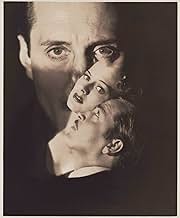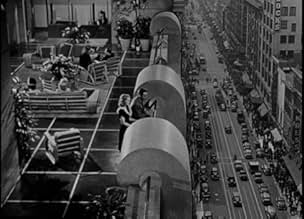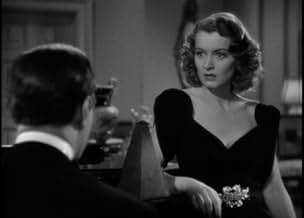अपनी भाषा में प्लॉट जोड़ेंA crazed physician marries a wealthy women and, with the help of his demented assistant, murders them for their money.A crazed physician marries a wealthy women and, with the help of his demented assistant, murders them for their money.A crazed physician marries a wealthy women and, with the help of his demented assistant, murders them for their money.
Barbara Jo Allen
- Louise Watkins
- (as Barbara Allen [Vera Vague])
Bobby Barber
- Bald Man in Library
- (बिना क्रेडिट के)
William 'Billy' Benedict
- Mickey Barnes - Copy Boy
- (बिना क्रेडिट के)
George Chandler
- Elevator Operator
- (बिना क्रेडिट के)
Edward Earle
- Librarian
- (बिना क्रेडिट के)
Chuck Hamilton
- Police Officer at Train Station
- (बिना क्रेडिट के)
Sam Harris
- Passerby
- (बिना क्रेडिट के)
Harry Hayden
- Ticket Clerk
- (बिना क्रेडिट के)
Douglas Kennedy
- Hotel Clerk
- (बिना क्रेडिट के)
Settar Körmükçü
- Dr. David Profesor
- (बिना क्रेडिट के)
John Laing
- Intern
- (बिना क्रेडिट के)
फ़ीचर्ड समीक्षाएं
Basil Rathbone stars with Ellen Drew in The Mad Doctor from 1940.
Rathbone plays a psychiatrist, George Sebastien, who is a black widower, marrying women for their money and then killing them. The last time, the doctor in charge of his wife's case (Ralph Morgan) is suspicious, but Sebastien convinces his assistant (Martin Kosleck) that the old man is harmless. As usual, they pick up stakes, this time moving to New York City.
Sebastien becomes aware of a beautiful young woman, Linda Boothe (Drew) who is depressed and suicidal. He agrees to take her case.
Her boyfriend (John Howard) doesn't believe in psychiatry and wants to discredit him. As a reporter, he writes a series of negative articles.
The problem here is that Howard takes such an instant dislike to the doctor that it just comes off as jealousy. However, Sebastien does get to the reason for Linda's problems - her own father's suicide - and helps her.
Sebastien has actually fallen for Linda and believes he has been cured of his desire to kill. That apparently arose from his first wife cheating on him.
This is a very entertaining if strange film. One wonders about the relationship between Sebastien and his assistant, who is furious that Sebastien wants to marry Linda and stop killing.
Rathbone is terrific - romantic, charming, and evil. Drew is a lovely actress and ideal in her role. Martin Kosleck as the bizarre assistant is just right.
Recommended. Rathbone is always good.
Rathbone plays a psychiatrist, George Sebastien, who is a black widower, marrying women for their money and then killing them. The last time, the doctor in charge of his wife's case (Ralph Morgan) is suspicious, but Sebastien convinces his assistant (Martin Kosleck) that the old man is harmless. As usual, they pick up stakes, this time moving to New York City.
Sebastien becomes aware of a beautiful young woman, Linda Boothe (Drew) who is depressed and suicidal. He agrees to take her case.
Her boyfriend (John Howard) doesn't believe in psychiatry and wants to discredit him. As a reporter, he writes a series of negative articles.
The problem here is that Howard takes such an instant dislike to the doctor that it just comes off as jealousy. However, Sebastien does get to the reason for Linda's problems - her own father's suicide - and helps her.
Sebastien has actually fallen for Linda and believes he has been cured of his desire to kill. That apparently arose from his first wife cheating on him.
This is a very entertaining if strange film. One wonders about the relationship between Sebastien and his assistant, who is furious that Sebastien wants to marry Linda and stop killing.
Rathbone is terrific - romantic, charming, and evil. Drew is a lovely actress and ideal in her role. Martin Kosleck as the bizarre assistant is just right.
Recommended. Rathbone is always good.
Quite a few reviews here have mentioned the ' relationship ' between Basil Rathbone's character and Martin Kosleck's character as being coded homosexuals. I thoroughly endorse this as I watched this film quite by accident on YouTube and I was surprised to see just how intimate in speech and gesture this couple were. The fact that they were both killers and that women had been murdered for their rich lifestyle reminded me of other homosexual killers in both ' Rope ' and ' Compulsion. ' and how somehow they got certificates in the UK admitting children with adults to see them. In the UK the film was called ' A Date with Destiny ' and not the horror signifier of ' The Mad Doctor ' which would have called out for an H certificate for adults only. Rathbone believes he has been saved from evil by falling in love with his last prospective victim, and his male partner, quite rightly becomes as righteously cross as an abandoned ' wife ' or ' husband. ' A Queer film indeed which has not as far as I can tell by historians of Queer and Gay cinema been noticed. America has been fiercely aggressive towards positive gay endings, even to today so any representation on screen of a possible gay character or two in a partner relationship has had to follow the tropes of abandonment, death or imprisonment. For a gay audience these negatives had to be also positives simply because homosexuality was overtly or implicitly seen on the screen. I could take a swipe at a few recent examples but I will concentrate on this 1941 film. Tim Whelan directs it well in Film Noir mode, and there are outstanding shots of New York during this period. The editing excellent and the acting exceptionally good, Ellen Drew as the last potential victim is perfect, shading her role from black mood to light laughter with professional expertise. I must mention Barbara Jo Allen as a friend who has a lot of great lines, delivered to perfection. A definite Paramount Eve Arden, lightening the film whenever she is in a scene. To sum up a taut thriller with touches of horror this deserves in my opinion a ten. A vastly underrated film on all levels. One final observation: the BBFC was very reluctant to give out H certificates during WW2, so that may explain the change of the film's title.
1940's "The Mad Doctor" is a sadly generic but wholly appropriate title for this Paramount feature, one of their rare genre efforts (working titles "The Monster" and "A Date with Destiny"). In the title role of Dr. George Sebastian, Basil Rathbone is not a 'mad doctor' as in 'mad scientist,' but a psychotic faux psychiatrist living with partner Maurice Gretz (Martin Kosleck), both wanted for murder in Vienna, having relocated to America. With the sudden demise of Sebastian's third wife, he takes up residence in New York City, where he begins another practice, meeting up with potential wife number four, hypochondriac Linda Boothe (Ellen Drew), whom Maurice believes would be the perfect candidate due to her suicidal tendencies (that would save them the trouble of bumping her off). Lurking in the background is Dr. Charles Downer (Ralph Morgan), a longtime friend of Sebastian's late wife, whose suspicions about her untimely death are soon confirmed, at his peril. This Ben Hecht story is loaded with promise, yet fudges its attempts at suspense with sketchy characterizations, virtually none of whom engender any sympathy, particularly the heroine, apparently as dim as the scatterbrained sister (Barbara Allen) that introduced her to Dr. Sebastian. The binding relationship between the doctor and Maurice is by far the most intriguing aspect to the film, but little footage is devoted to their villainy, the pace slowed to a crawl by endless romantic twaddle. The final third almost makes up for all these faults, but the excellent cast is left pretty much on their own. Ellen Drew was much better, and far more sympathetic, in another Paramount, "The Monster and the Girl," while Martin Kosleck easily steals his scenes from the rather surprisingly uninspired Rathbone (much better in "Kind Lady"), soon to enjoy one of his finest villains opposite Tyrone Power in "The Mark of Zorro."
"Oh, there's no such thing as sanity. At it's best a heroic and precarious little hiding place in which we try to conceal ourselves from the devils...The devils of time, space, things unknown, and the past."
Although its title suggests conventional horror, "The Mad Doctor" is a pitch black thriller with some with some truly harrowing subject matter. Basil Rathbone plays Dr. Sebastien, a Bluebeard-like psychiatrist who recently killed off his wealthy wife Ida. After arousing the suspicion of local doctor Ralph Morgan, Rathbone leaves town. He soon finds his next mark, a deeply troubled young socialite named Linda that's been suffering with suicidal ideations.
Rathbone is accompanied in his efforts by Martin Kosleck as Maurice, a sort of male secretary. After seeing these two interact, it becomes very clear that they are more than criminal accomplices. When we see Kosleck in Rathbone's home or office, he's variously arranging flowers, spritzing himself with cologne, fussing with Rathbone over a choice of tie, and languorously sketching a black cat while wearing a bathrobe. When Rathbone starts to become genuinely interested in Linda, Kosleck responds with wounded jealousy.
This is very obviously a coded gay relationship, years ahead of the one in Hitchcock's "Rope." The scenes between Rathbone and Kosleck, both superb actors, positively crackle. In one scene, Rathbone gives a bone chilling monologue describing his contempt for dead wife Ida: "These atrocious paintings. This absurd wallpaper. These pathetic antiques. They all breathe her spirit. I can almost see her now coming down those stairs with that foolish smile and the love light in her eyes. I can never forgive her the eight months spent in this cave of romance."
The danger and intensity only ratchet up from there, climaxing in a truly haunting and beautifully executed ending. This is one of Basil Rathbone's most underrated films.
Although its title suggests conventional horror, "The Mad Doctor" is a pitch black thriller with some with some truly harrowing subject matter. Basil Rathbone plays Dr. Sebastien, a Bluebeard-like psychiatrist who recently killed off his wealthy wife Ida. After arousing the suspicion of local doctor Ralph Morgan, Rathbone leaves town. He soon finds his next mark, a deeply troubled young socialite named Linda that's been suffering with suicidal ideations.
Rathbone is accompanied in his efforts by Martin Kosleck as Maurice, a sort of male secretary. After seeing these two interact, it becomes very clear that they are more than criminal accomplices. When we see Kosleck in Rathbone's home or office, he's variously arranging flowers, spritzing himself with cologne, fussing with Rathbone over a choice of tie, and languorously sketching a black cat while wearing a bathrobe. When Rathbone starts to become genuinely interested in Linda, Kosleck responds with wounded jealousy.
This is very obviously a coded gay relationship, years ahead of the one in Hitchcock's "Rope." The scenes between Rathbone and Kosleck, both superb actors, positively crackle. In one scene, Rathbone gives a bone chilling monologue describing his contempt for dead wife Ida: "These atrocious paintings. This absurd wallpaper. These pathetic antiques. They all breathe her spirit. I can almost see her now coming down those stairs with that foolish smile and the love light in her eyes. I can never forgive her the eight months spent in this cave of romance."
The danger and intensity only ratchet up from there, climaxing in a truly haunting and beautifully executed ending. This is one of Basil Rathbone's most underrated films.
There is something really quite sinister to Basil Rathbone's title performance in this rather intimidating psychological thriller. We know from the outset that he has disposed of his wife "Ida" - ostensibly pneumonia - but the local physician "Dr. Downer" (Ralph Morgan) is suspicious. Shortly after cleaning up on the inheritance, he moves with his friend "Maurice" (Martin Kosleck) to start afresh. Now you don't have to be Einstein to recognise that these two men are more than just roomies, and that causes a bit of consternation when "Dr. Sebastian" finds new prey. This time, in the guise of the deeply troubled "Linda" (Ellen Drew). With a marriage and a trip to Quito on the cards, might history be about to repeat itself? Well, fortunately for "Linda" reporter "Sawyer" (John Howard) is also a bit suspicious of the man, and after a bit of investigation and a chat with "Downer", the two begin to piece together quite a different persona for Rathbone than the one he has been successful peddling thus far. Can they act in time to thwart his malevolent plan? Tim Whelan allows his star to exude menace here. The script is really only adequate, but the pace is good and the gradually accumulating sense of peril - and a wonderfully seedy contribution from the increasingly envious "Maurice" leads us towards a conclusion where nothing is predictable. Actually, on that front I was a little disappointed, but all in all, this is a dark and effective tale of manipulation that is well worth a watch.
क्या आपको पता है
- ट्रिवियाOne of over 700 Paramount Productions, filmed between 1929 and 1949, which were sold to MCA/Universal in 1958 for television distribution, and have been owned and controlled by Universal ever since; its earliest documented telecast took place in Seattle Monday 11 May 1959 on KIRO (Channel 7).
- भाव
Maurice Gretz: You're like all the other clever ones, clever until they meet a woman, and then they suddenly become fools.
- कनेक्शनReferenced in Svengoolie: Night Monster (2015)
- साउंडट्रैकAloha 'Oe
Music by Queen Liliuokalani
टॉप पसंद
रेटिंग देने के लिए साइन-इन करें और वैयक्तिकृत सुझावों के लिए वॉचलिस्ट करें
- How long is The Mad Doctor?Alexa द्वारा संचालित
विवरण
- चलने की अवधि1 घंटा 30 मिनट
- रंग
- पक्ष अनुपात
- 1.37 : 1
इस पेज में योगदान दें
किसी बदलाव का सुझाव दें या अनुपलब्ध कॉन्टेंट जोड़ें




































